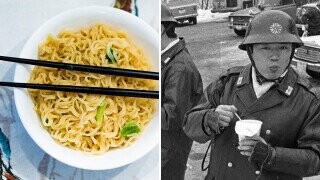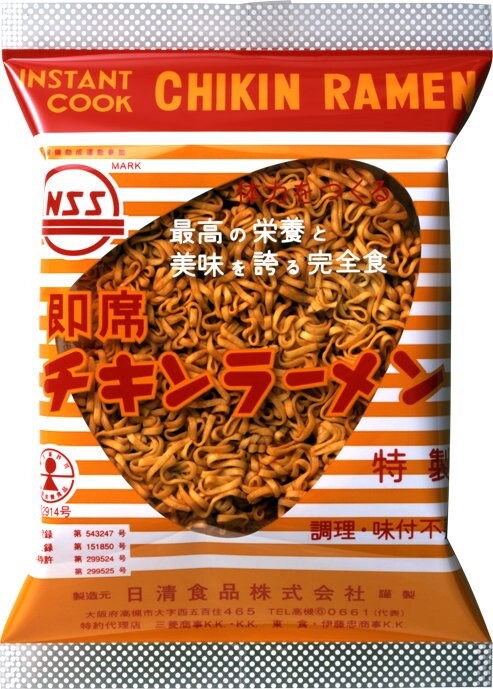A Look At The Invention Of Instant Ramen

The United States is a country of impressive eaters. Not only the darkly fascinating world of eating competitions, where we watch someone hoover up hot dogs like they’re weed brownies during a traffic stop, but just the generous portion sizes for regular meals that can shock foreigners. You don’t nurture an unending obesity crisis without taking down a pretty impressive national calorie total. The U.S. also has one of the most varied and international menus available to eat this shocking amount of food. Calling the United States a global melting pot might be even more apt than intended.
Now, the specific tastes of each generation do change. Nobody in the 1990s was eating Acai bowls, in the same way that no one now is drinking whatever the hell Orange Julius was. Some staples, however, seem to persist as a popular choice regardless of era or circumstance. Whether the economy is booming or blowing up in our faces, whatever the latest hot cuisine might be, some foods are just unimpeachable in their presence. Foods like hamburgers, pizza, fried chicken, and, I would argue: instant ramen.
Don't Miss
Though instant ramen might seem quite a bit more foreign than the other aforementioned foods, it’s completely and firmly cemented itself in our collective food memory. It would be difficult to find someone in the United States today who’s never had a cup or bowl of Top Ramen or similar. It’s become practically a synonym for a cheap meal, and a stereotype of the college diet. But when did the cheap curly noodles that now firmly have us wrapped within their grasp come about? Let’s take a look at the evolution of the instant ramen noodle through the years.
1945: Inspiration For Momofuku Ando
The inventor of instant noodles, and with them, the founder of the Nissin company, is a man by the name of Momofuku Ando. If you recognize the name Momofuku from the chain of the same name run by famous chef David Chang, yes–he is its namesake. Ando’s legacy goes back all the way to 1945, after Japan had surrendered in World War 2. Ando was walking through a splintered Osaka when he saw huge lines for ramen carts. This, according to Ando, gave him the inspiration to create easy, convenient, affordable food.

1957: Ando Takes Action
Despite this lightbulb moment, Momofuku Ando did not immediately take to the kitchen. He had another job, as a bank manager, and one could guess he and his family were much more comfortable with the stability that gave versus trying to invent an entirely new type of food. But in 1957, the bank failed, and Ando suddenly found himself with a whole lot of free time, a need for a new business, and still that one idea from years back.
He then, as the story goes, began to buy second-hand noodle-making equipment, and tried to figure out a way to make noodles that not only were shelf-stable, but could be prepared in minutes. He went through a whole lot of frustration and even more bad noodles before finding the solution somewhat by accident. Legend says he saw his wife heating oil to fry tempura and tossed the noodles in, finding his solution. These fried noodles (though air-dried now, in the name of health concerns) stayed fresh for much longer, and the frying added tiny perforations that made them cook quicker.
1958: Nissin Chikin Ramen

Nissin Foods
Ando then founded a company that still stands large in the ramen industry: Nissin. Their first product would be called “Chikin Ramen,” and though certainly similar to the ramen we’re used to today, it had one major difference that might be surprising: it was not cheap. In fact, the original Chikin Ramen was actually MORE expensive than ramen from a local stand. However, Ando found that the Japanese public was more than willing to pay a premium for the convenience of a quick, filling meal, and Chikin Ramen was a bonafide smash hit.
1966: Ando Goes To America
With Nissin and Chikin Ramen taking Japan by storm, in 1966, Ando looked to expand overseas. Japanese food was starting to inspire curiosity in the increasingly international palates of Americans, and Ando saw an opening for ramen. However, as he traveled to promote it, he found that in the United States, bowls and chopsticks weren’t quite as omnipresent as in Japan. When in meetings promoting Chikin Ramen to supermarket owners, Ando watched with curiosity as they would break up the noodle blocks and add them to their styrofoam coffee cups with hot water to try them, and there he found the genesis for Nissin’s next massive product: Cup Noodles.
1971: Cup Noodles Debut

After a few years of development, the idea sparked in those supermarket meetings came to fruition when Nissin launched the Cup Noodle, instant ramen that was served in its own heat-resistant (but famously, not microwave-resistant) serving vessel. Even though this variation was even more expensive due to the extra manufacturing, again, convenience beat out cost and Ando had a phenomenon on his hands.
1972: First U.S. Nissin Factory
Noodles revolutionized and cups conquered, Nissin opened its first American factory in 1972 in Gardena, California. They began producing the first ever American-made instant ramen, under the still-everpresent brand “Top Ramen,” and college students’ sodium intake was forever altered.
Even as full-service, full-price ramen shops have enjoyed a moment in American over the last couple of years, for many, the word “ramen” still brings to mind the classic, plastic-wrapped bricks that we’d rip apart with tiny young hands after school or class. Ando’s original dream of creating a food that could help end hunger may have seemed grand, but he came closer than perhaps anyone thought possible. Ando, and Nissin, created a new-world staple that remains a food foundation through times both fat and lean.
Top Image: